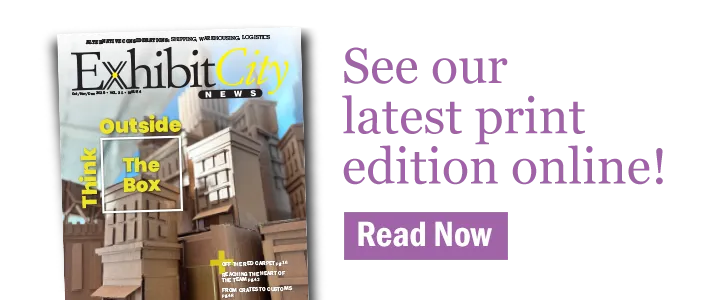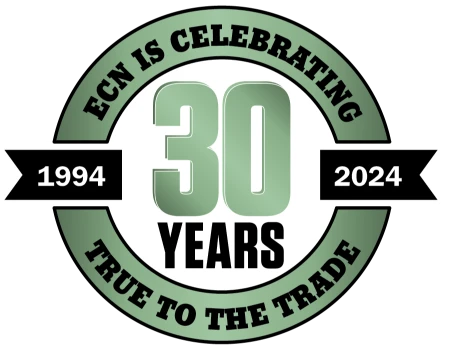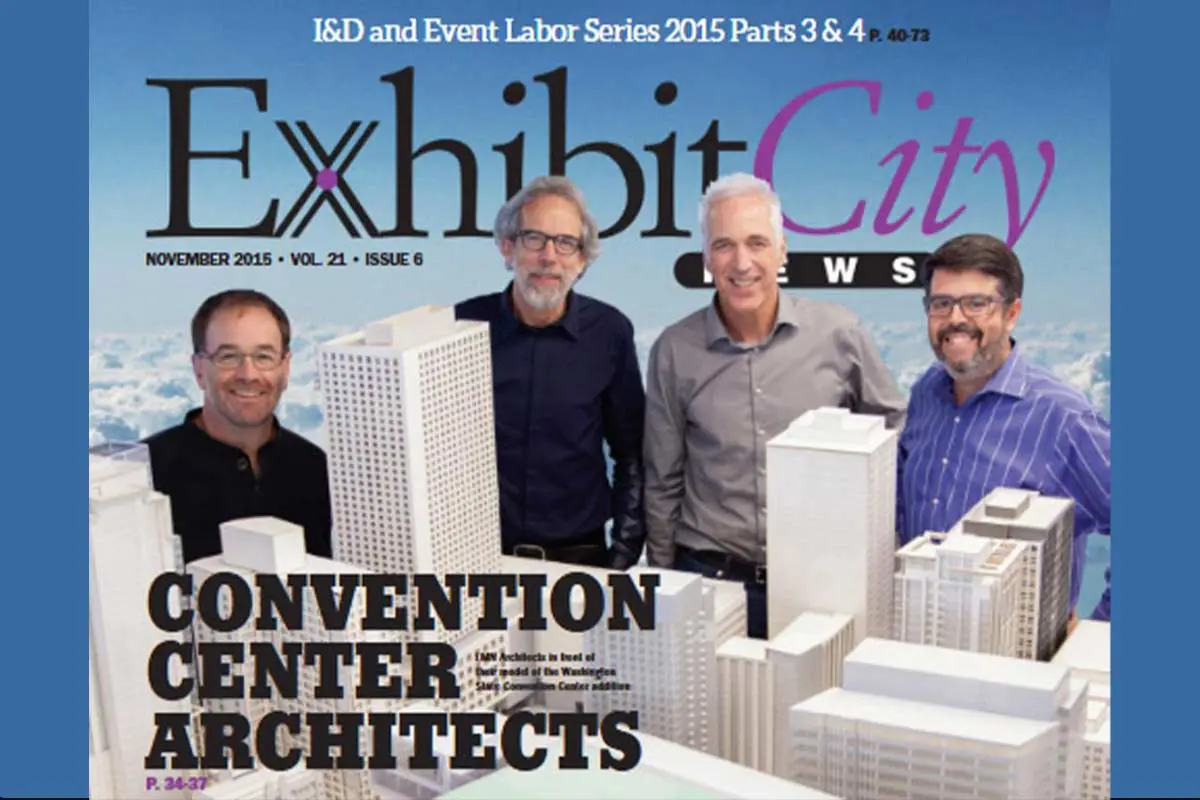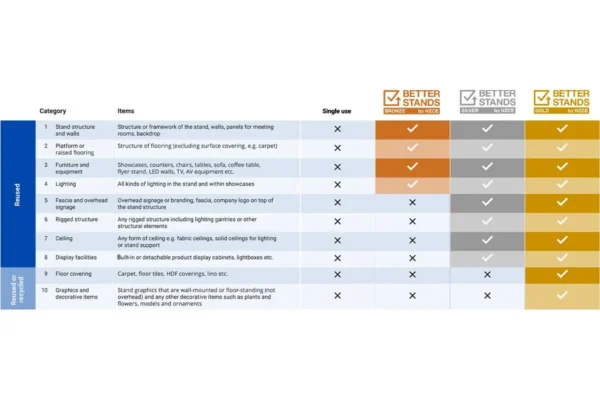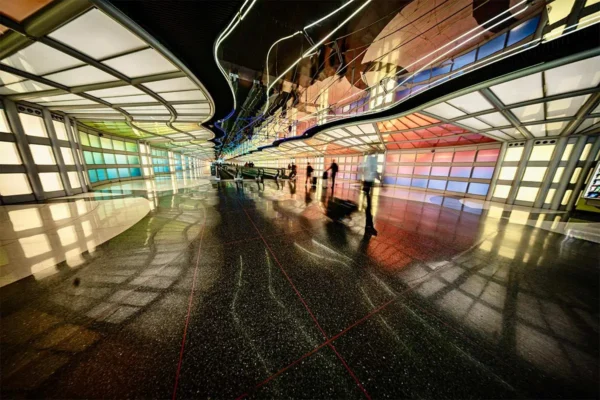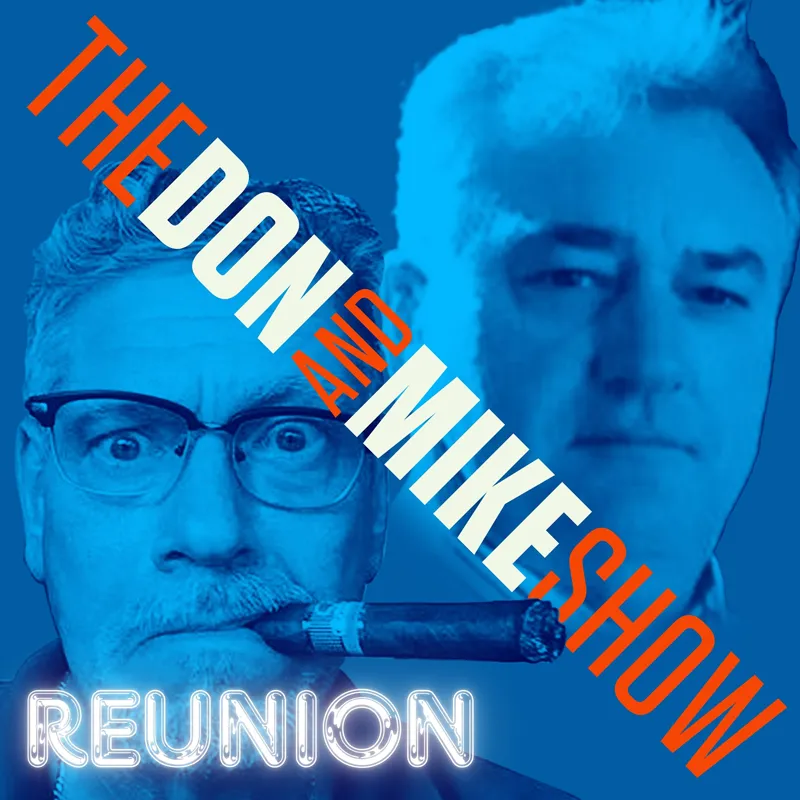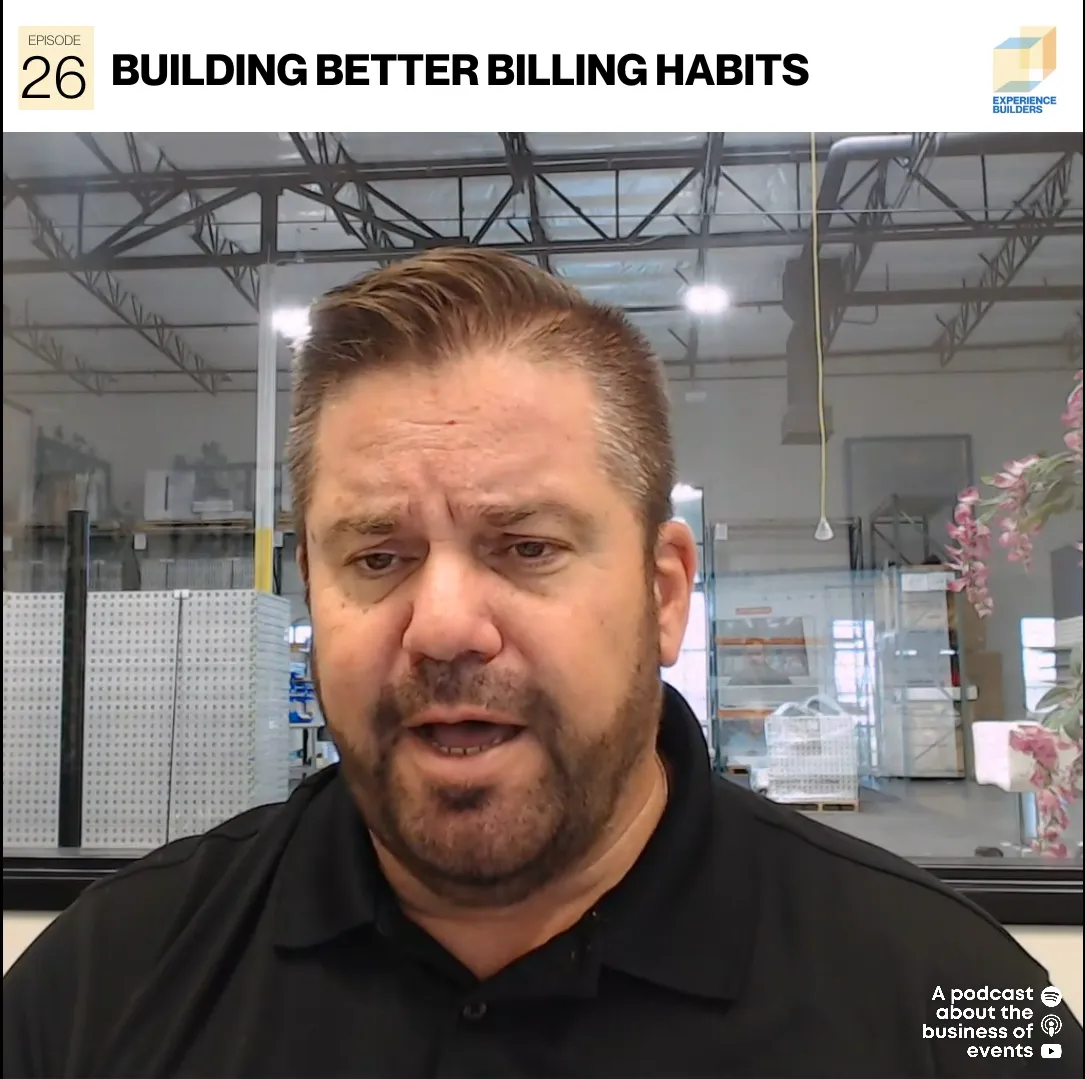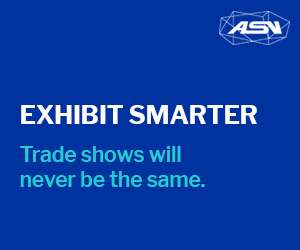(Cover of Exhibit City News 10 years ago, November 2015. Left to right: Brian Tennyson, Mark Reddington, George Shaw, and Rafael Viñoly-Menendez, featured in ECN’s Convention Center Architects issue exploring the people behind modern convention center design. Read the full issue here.)
From the tech boom of COMDEX to the lockdown lessons of 2020, November has often marked turning points for the tradeshow world. Across 25 years of headlines, the month has captured moments of innovation, resilience, and reinvention. This edition of A Look Back revisits stories that shaped the industry’s path, including women pushing for equity in 2005, digital marketing’s early rise in 2010, and the comeback spirit that carried organizers through the pandemic.
Have a memory, photo, or issue to share from ECN’s archives? Email Mark at markh@exhibitcitynews.com to be featured in a future edition.
Five Years Ago — November 2020
Why Virtual Events Aren’t Popular and the Traditional Tradeshow Will Never Die
In 2020, as the pandemic forced the industry online, many questioned whether virtual events could replace the live tradeshow experience. Guy Zurick argued they could not. He noted that while digital meetings offered convenience, they lacked the personal connection, creativity, and shared energy that define in-person events. His message reflected the industry’s resilience at a time of uncertainty and reinforced the belief that tradeshows would return stronger than ever once doors reopened.
“The Don & Mike Show” Seeks Path to Move Forward
As the industry faced shutdowns and uncertainty in 2020, The Don & Mike Show continued to bring together voices from across the tradeshow community. Hosts Don Savella and Mike Morrison used the podcast to share insights, challenges, and solutions as event professionals navigated cancellations and evolving safety protocols. Their conversations provided connection and perspective at a time when much of the industry was searching for direction and hope for recovery.
Ten Years Ago — November 2015
Social Media at Tradeshows
As exhibitors embraced digital tools, social media became a powerful driver of visibility and engagement on the show floor. Cindy Pereira’s 2015 column emphasized how platforms like Twitter, LinkedIn, and Instagram allowed companies to connect with attendees before, during, and after events. She advised exhibitors to post authentic content, engage followers in real time, and focus on building relationships rather than simply promoting products. Her message still resonates today: social media success depends on strategy, timing, and genuine interaction.
5 Ways to Improve Your Tradeshow Marketing
Exhibitors in 2015 were shifting from static displays to fully immersive experiences. SuccessFactors’ collaboration with Group Delphi offered a blueprint for success, emphasizing five key strategies: partner early with creative teams, design for the customer experience, maintain a consistent theme, connect emotion to the brand, and never deviate from core messaging. Their approach proved that thoughtful storytelling and cohesive design could transform a booth into an environment that inspires, educates, and strengthens brand loyalty.
Business Visitor Visa
As global exhibiting increased, many international exhibitors faced challenges navigating U.S. labor laws. Under business visitor visa rules, foreign companies could attend and oversee exhibits but were prohibited from performing installation and dismantle work. The restriction often led to confusion, higher costs, and reliance on local labor teams. Industry advocates warned that the rules created competitive disadvantages for international exhibitors and highlighted the need for clearer standards that balance labor protections with global business realities.
Fifteen Years Ago — November 2010
Social Media Explosion Reaches Exhibition Industry
Digital and social media marketing reshaped how exhibitors and organizers connected with audiences in 2010. Research from the Center for Exhibition Industry Research (CEIR) and George P. Johnson Experience Marketing found that event professionals were increasingly using tools such as Facebook, LinkedIn, and Twitter to promote shows and measure engagement. Nearly 70 percent of respondents cited improved brand awareness and higher return on investment from digital campaigns. Industry leaders predicted that social media would soon become an essential part of tradeshow strategy, driving attendee interaction before, during, and after each event.
Business Aviation Show Has Signs of Renewed Life
The National Business Aviation Association Annual Meeting and Convention (NBAA-BACE) is where you can get up close with the newest business aircraft, meet showed strong signs of recovery as the industry emerged from the global recession. Held in Orlando, the event drew more than 23,000 attendees and over 1,000 exhibitors, surpassing the previous year’s totals. Exhibitors showcased the latest aircraft, maintenance technologies, and aviation services, reflecting cautious optimism across the business aviation sector. Organizers credited improved confidence in corporate travel spending for the show’s momentum and called the turnout a promising indicator for continued growth.
Brumark Launches Flooring Solutions Website
Brumark introduced its Total Flooring Solutions website to give exhibitors and event professionals an easier way to access products, specifications, and installation resources. The site featured information on carpet, raised flooring, printed graphics, and specialty materials for exhibits and corporate environments. Company leaders said the online platform would simplify project planning and improve client service by centralizing technical data and support tools. The launch reflected the industry’s growing move toward digital solutions for purchasing and event preparation.
Hill & Partners Celebrates Fifteen Year Anniversary
Hill & Partners marked its fifteenth year as a full-service exhibit design firm serving clients across six continents. Founded in 1995 in Quincy, Massachusetts, the company built its reputation on creative collaboration, strategic design, and personalized service. Its founders emphasized a flexible, partnership-based approach that allowed the team to deliver tailored solutions for each project. Over fifteen years, Hill & Partners grew into one of the industry’s respected leaders, known for blending inspired design with strong account management and long-term client relationships.
Twenty Ago — November 2005
Women Speak Out About Industry Challenges
Woman leaders from across the exhibit and event industry shared candid perspectives on career advancement, pay equity, and the need for greater representation in leadership roles. Peggy Swords, Candace Adams, Kimbra Fracalossi, Tamara Christian, and Tina Vedovat each reflected on their paths in a business still dominated by men, emphasizing mentorship, confidence, and perseverance as keys to success. Many called for broader recognition of women’s contributions and stronger educational opportunities within the tradeshow community. Their insights anticipated today’s industry-wide focus on inclusion, mentorship, and professional development.
Las Vegas Convention Center Study Calls for Enhancements
A strategic review of the Las Vegas Convention Center (LVCC) outlined several recommendations to strengthen security and improve the visitor experience. The Las Vegas Convention and Visitors Authority (LVCVA) proposed upgrades to interior finishes, technology, and connectivity between halls. The plan also called for adding a Las Vegas Metropolitan Police Department (LVMPD) substation on site to improve safety for exhibitors and attendees. Officials said the updates would help the facility remain competitive as one of the world’s top destinations for major conventions and meetings.
All in the Family: Absolute is Absolutely a Family Business
Family-owned and operated, Absolute Exhibits built its reputation on collaboration, creativity, and hands-on leadership. Founded by Don Koren and joined by his wife Jan and sons Todd, Scott, and Mike, the Orange, California-based company specialized in custom exhibits, rentals, and graphics for clients across the United States and abroad. As international demand grew, the Korens expanded their reach to Europe and Asia, offering bilingual services and personal attention to detail. “We’re aggressive and keep up with what’s new every day,” Jan Koren said at the time. Their approach reflected a growing trend of family-led exhibit firms that balanced craftsmanship with global capability.
Bill Gates, Paul Otellini to Speak at CES
The Consumer Electronics Association (CEA) announced that Microsoft Chairman Bill Gates and Intel president and CEO Paul Otellini would deliver keynote addresses at the 2006 International Consumer Electronics Show (CES) in Las Vegas. CES 2006 was expected to host more than 2,500 exhibitors showcasing innovations in computing, mobile technology, and digital entertainment. Organizers emphasized the event’s expanding role in driving collaboration between hardware and software companies as new digital lifestyles emerged. The conference reflected a pivotal shift in technology marketing, where convergence and connectivity began shaping the modern tradeshow landscape.
Twenty-Five Years Ago — November 2000
COMDEX Surpasses One Million Net Square Feet
In November 2000, COMDEX/Fall cemented its reputation as the world’s premier information technology marketplace, surpassing one million net square feet of exhibit space at the Las Vegas Convention Center. Produced by Key3Media Events, the show hosted more than 2,300 exhibitors from 18 countries and drew over three-and-one-half million buyers and sellers worldwide. Exhibits featured emerging technologies in broadband networking, handheld devices, digital publishing, and e-commerce. COMDEX/Fall 2000 also expanded its focus to community-specific conferences, including Linux Business Expo and Customer 360, reflecting early efforts to segment tech audiences.
Top Ten Tradeshows: What Does the Future Hold?
Industry leaders in 2000 debated whether tradeshows had life cycles and how technology might reshape their future. Despite rapid advances in the Internet and digital communication, major events such as CES, CONEXPO-CON/AGG, the International Housewares Show, IMTS, and COMDEX remained strong. Attendance and exhibit space continued to grow, driven by new product launches and hands-on demonstrations that online channels couldn’t match. Organizers agreed that while virtual tools offered convenience, the tradeshow floor delivered what technology could not: direct interaction, collaboration, and trust. One executive summarized the sentiment of the time, saying, “In a way, tradeshows are Internet-proof because of the personal interaction.”
Southern California Convention Centers Rise in Popularity
In 2000, Southern California emerged as one of the country’s fastest-growing tradeshow markets. The Los Angeles Convention Center (LACC), San Diego Convention Center (SDCC), and Anaheim Convention Center (ACC) all reported record bookings, while facilities in Riverside, Pasadena, and Ontario strengthened regional demand. Warm weather, diverse industries, and modernized infrastructure attracted both national and international events to the area. The region’s steady investment in space and technology positioned it as a long-term hub for meetings and exhibitions, a reputation it continues to hold 25 years later.



